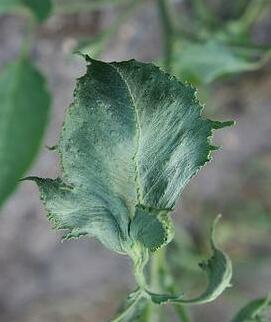
1 minute read
Herbicide Damage
Description
Herbicide damage occurs when a broadleaf herbicide contacts the plant either directly or indirectly via drift, vapor, or herbicide residues in soil, mulch, or compost materials. Symptoms include small misshaped leaves that are thick and tightly curled, stunted growth, and dieback in severe exposure. Plants may recover from minor damage, but yields are typically reduced. Some herbicides that are sprayed during hot temperatures can volatilize with long-distance drift of vapors, while others drift to nearby plants on windy days.
Management
Avoid accidental exposure by following label application directions for temperature, wind speed, correct nozzle size, and spray pressure. Use a hooded sprayer, increase the droplet size, add a spray additive to reduce drift, thoroughly clean sprayers after use, and avoid spraying when winds are blowing toward the crop. Tomato plants that are exposed to small doses of herbicide damage will likely recover. If exposure is determined to be from mulch or compost, then immediately stop using and remove infected compost.
Timing
Herbicide damage can occur at any time during the growing season but is most common during dry, hot, or windy days after herbicides have been applied nearby.
Jan Feb Mar Apr May Jun Jul Aug Sep Oct Nov Dec













